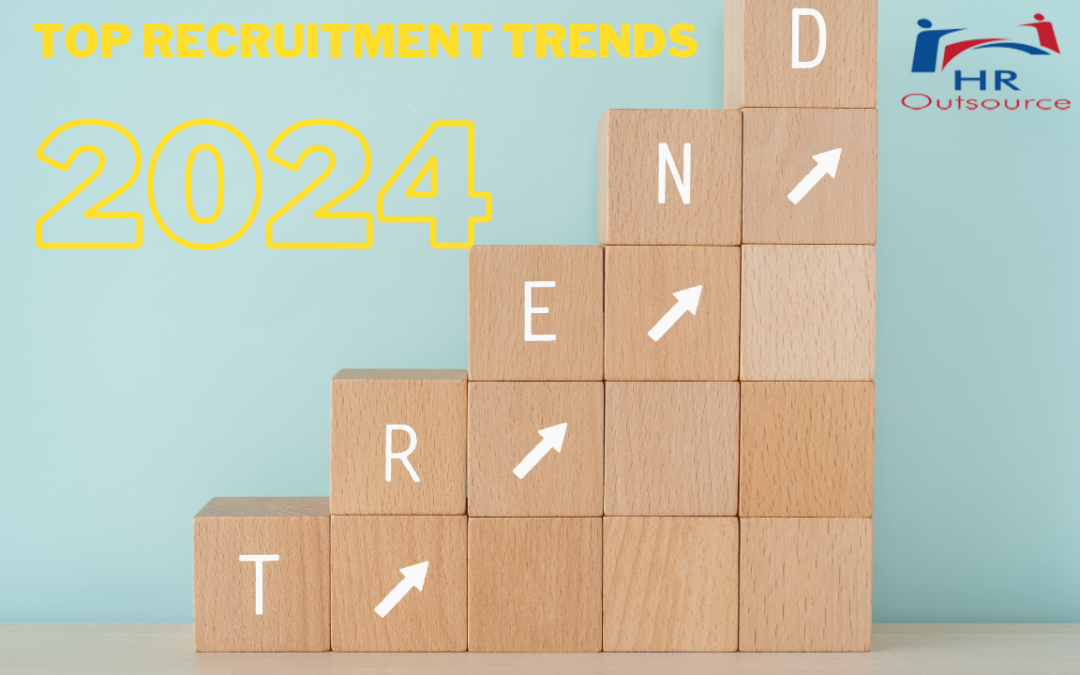As we enter 2024, the recruitment landscape is witnessing a rapid transformation, driven by a dynamic job market that blends technological advancements, evolving candidate expectations, and changing business needs. Traditional recruitment strategies are being replaced by more innovative, agile approaches as organizations harness technology, automation, AI, and data analytics to streamline hiring and identify suitable candidates.
The rise of remote work has expanded the global talent pool, presenting both opportunities and challenges in selecting candidates who are not just skilled but also align with company culture and values. Staying ahead in this fast-evolving market is crucial for companies to secure top talent and build teams that drive growth and innovation.
This blog post aims to deep dive into the dominant recruitment trends of 2024, offering insights and strategies for HR professionals, recruiters, and business leaders. The focus spans technological progress in recruitment, the increasing importance of employer branding, the impact of AI and automation, and the growing significance of soft skills and cultural fit.
Our goal is to provide a comprehensive guide that balances professional insight with approachability, equipping readers with knowledge and tools for effective recruitment strategies in this ever-changing landscape.
Technology-Driven Recruitment

The recruitment world is rapidly embracing technology, leveraging its potential to streamline processes, enhance candidate experience, and make more informed hiring decisions. In this section, we will explore the various facets of technology-driven recruitment, focusing on the integration and impact of AI, VR, AR, and automation in the hiring landscape of 2024.
AI-Driven Hiring
Integration of AI and Machine Learning in the Hiring Process
The incorporation of AI and machine learning in recruitment is revolutionizing hiring. AI algorithms now streamline resume screening and chatbots serve as initial points of contact, enhancing efficiency and candidate engagement.
Virtual Reality (VR) and Augmented Reality (AR) for Immersive Candidate Assessments
Additionally, the recruitment landscape is witnessing an innovative shift with the application of Virtual Reality (VR) and Augmented Reality (AR) in candidate assessments. These technologies offer simulated work environments for a more interactive and lifelike evaluation of candidates’ skills, also giving them a glimpse of the company’s culture. This approach significantly enhances the assessment process by providing a realistic context to candidates’ abilities.
Automation of Repetitive Tasks to Enhance Efficiency in the Recruitment Workflow
Complementing these advancements, automation is being increasingly leveraged in recruitment to streamline repetitive and time-consuming tasks. This encompasses scheduling interviews, managing follow-up communications, and updating candidate databases. The automation of these aspects frees up recruiters to focus on more strategic elements of recruitment, such as deepening candidate engagement and refining decision-making processes, thereby overall elevating the recruitment workflow’s efficiency.
Overview of Technology-Driven Recruitment Tools
| Technology | Application in Recruitment | Benefits |
| AI in Screening | Resume parsing, Candidate shortlisting | Speed, Accuracy, Reduced Bias |
| Chatbots | Initial interaction, Scheduling | Efficiency, 24/7 Candidate Engagement |
| VR/AR | Skill assessments, Immersive experience | Realistic Evaluation, Candidate Engagement |
| Automation Tools | Scheduling, Emailing, Database Management | Time-saving, Focus on Strategic Tasks |
By embracing these technology-driven approaches, companies are not only optimizing their recruitment processes but are also positioning themselves as forward-thinking employers. This, in turn, attracts top talent who are looking for workplaces that value innovation and efficiency.
The integration of AI, VR, AR, and automation in the recruitment process is not just a trend but a significant shift towards a more dynamic, efficient, and candidate-centric hiring approach. As we move further into 2024, these technologies will continue to shape and redefine the recruitment landscape.
Preparing Workforce for Generative AI and Automation

As we step into 2024, the impact of generative AI and automation on the workforce is more evident than ever. Organizations need to strategize and adapt their workforce to harness the full potential of these technological advancements. This involves understanding the implications of AI and automation, identifying the skill gaps they create, and developing strategies to address these gaps.
Remote Work and Hybrid Models
The Impact of the Global Shift Towards Remote Work
The global shift towards remote work has been one of the most significant changes in the work environment in recent years. This shift has led to:
Increased Flexibility: Employees enjoy greater flexibility in terms of work hours and location.
Diverse Talent Pool: Companies can now tap into a global talent pool, hiring the best talent irrespective of geographical boundaries.
Rise of Hybrid Work Models and Their Implications on Recruitment Practices
Hybrid work models, a blend of in-office and remote work, are becoming increasingly popular. This model requires:
Adaptability in Recruitment: Recruitment strategies must be flexible to accommodate both remote and in-office requirements.
Emphasis on Collaboration Tools: Familiarity with collaboration tools becomes a vital skill for candidates.
Skill-Based Hiring and Upskilling

Shift from Traditional Qualifications to a Focus on Skills and Competencies
There is a growing trend towards valuing skills and competencies over traditional qualifications. This shift emphasizes:
Practical Skills: Real-world skills that are directly applicable to job roles.
Soft Skills: Skills like problem-solving, adaptability, and teamwork are highly valued.
Importance of Ongoing Learning and Upskilling for Both Employers and Employees
Upskilling is essential for both parties:
For Employers: It ensures their workforce stays relevant and competitive.
For Employees: It provides career growth opportunities and job security in a changing job market.
Tools and Platforms for
Assessing and Validating Candidate Skills
To effectively assess and validate candidate skills, several tools and platforms have emerged:
- Online Skill Assessment Platforms: Tools like coding simulators and virtual project environments allow employers to assess candidates’ practical skills in real-time.
- Digital Portfolios and Credentials: Candidates can showcase their skills through online portfolios and verified digital credentials.
- AI-Based Skill Assessment Tools: These tools use AI to evaluate a candidate’s skill level, providing insights beyond what is visible on a resume.
Diversity, Equity, and Inclusion (DEI)
Growing Emphasis on Creating Diverse and Inclusive Workplaces
The importance of diversity, equity, and inclusion in the workplace has gained significant traction. It’s recognized not just as a moral imperative but also as a key driver of innovation and business success. Diverse teams bring a variety of perspectives, leading to more creative solutions and better decision-making.
Strategies for Promoting Diversity in Recruitment
To foster diversity in recruitment, organizations are implementing:
- Blind Hiring Practices: This involves anonymizing resumes to prevent unconscious biases based on name, gender, or ethnicity.
- Diverse Hiring Panels: Ensuring the hiring panel is diverse can help mitigate bias in the decision-making process.
- Targeted Outreach: Actively reaching out to diverse communities and platforms can widen the pool of diverse candidates.
Tools and Technologies for Mitigating Bias in the Hiring Process
Various tools and technologies are being employed to reduce bias:
AI-driven Tools: These tools help in screening candidates based on skills and experiences, disregarding demographic factors.
Bias Training Programs: Implementing training programs for recruiters and hiring managers to recognize and reduce unconscious biases.
Employer Branding and Candidate Experience
Building a Strong Employer Brand to Attract Top Talent
An employer brand that resonates with values and culture can significantly attract top talent. This includes:
Showcasing Company Culture: Through various media, highlight what makes the company a great place to work.
Employee Testimonials: Sharing current employees’ positive experiences can be a powerful tool for attracting candidates.
Enhancing the Overall Candidate Experience During the Recruitment Process
The candidate experience during recruitment has a lasting impact. This involves:
Streamlining the Application Process: Make the application process straightforward and user-friendly.
Regular Communication: Keep candidates informed about their application status and provide feedback.
Utilizing Social Media and Other Platforms for Effective Employer Branding
Social media platforms are a goldmine for employer branding:
Leveraging LinkedIn, Twitter, Facebook: Regular posts about company culture, achievements, and job openings can increase visibility and attractiveness to potential candidates.
Data-driven Decision Making

Harnessing Big Data and Analytics in Recruitment
Big data and analytics have become indispensable tools in modern recruitment. They enable companies to:
Analyze Trends: Understand patterns in employee success and retention.
Streamline Recruitment Processes: Identify which channels bring in the most qualified candidates.
Customize Recruitment Strategies: Tailor strategies based on data-driven insights about what works best.
Predictive Analytics for Identifying Potential Candidates
Predictive analytics uses historical data to predict future outcomes. In recruitment, this means:
Identifying Potential Candidates: Analyzing past hiring data to predict which candidates are likely to succeed.
Forecasting Hiring Needs: Predicting future hiring needs based on company growth and turnover rates.
Improving Decision-Making Processes Through Data-Driven Insights
Data-driven insights contribute significantly to refining recruitment decisions:
Reducing Hiring Biases: Data helps in making objective decisions based on candidate skills and potential.
Measuring Recruitment Success: Metrics like time-to-hire and employee turnover rates provide insights into the effectiveness of the recruitment process.
Evolving Role of Recruitment Professionals
The Changing Role of Recruiters in the Face of Technological Advancements
The role of recruitment professionals is rapidly evolving, driven largely by technological advancements. Today’s recruiters are not just talent scouts but also strategists and tech-savvy innovators. They are expected to leverage AI tools, understand data analytics, and navigate online recruitment platforms effectively. This shift demands a more analytical approach, where recruiters must interpret data to make informed hiring decisions.
Importance of Adaptability and Continuous Learning for Recruitment Professionals
Adaptability and continuous learning are key for recruiters in this evolving landscape. They need to:
- Stay Informed About Technological Developments: This includes AI, machine learning, and data analytics tools that are reshaping recruitment.
- Embrace Continuous Professional Development: Participating in workshops, webinars, and training sessions helps recruiters stay ahead of the curve.
Collaboration with HR Tech Experts and Data Scientists
Effective collaboration between recruiters, HR tech experts, and data scientists is crucial. This partnership allows for:
Better Implementation of Technologies: HR tech experts can guide recruiters in effectively using new tools.
Data-Driven Insights: Collaboration with data scientists can lead to more informed hiring strategies based on analytics.
Conclusion
As we look back at the key recruitment trends for 2024, it’s clear that technology, diversity, flexibility, and data-driven decision-making are at the forefront. These trends reflect a broader shift in the job market and workplace expectations, calling for a more dynamic and inclusive approach to recruitment. Organizations must be proactive in adapting to these changes.
Embracing new technologies, fostering diversity, and implementing flexible work models are no longer optional but essential for attracting and retaining top talent. Companies need to reassess their recruitment strategies to align with these evolving trends. Recruiters play a pivotal role in navigating this changing landscape. Staying informed about the latest trends, adopting new technologies, and continuously upskilling are crucial for success in this role. Recruiters must view these changes not as challenges but as opportunities to innovate and excel in their field.

